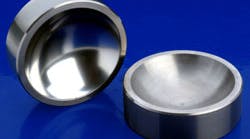A laser-polished spherical cap (left) shown with the same product in its unfinished state (right). Photo and sample by courtesy of the Fraunhofer Institute for Laser Technology.
Free-form, automated laser polishing of a surface using a robot. Photo by courtesy of the Fraunhofer Institute for Production Technology.
Low-cost suppliers of injection molds and diecasting molds are presenting a serious threat to the tooling industry in Europe, which remains a sizable and valuable market sector with an annual turnover of Euro 13 billion (about $18 billion). For the mostly small and medium-sized European companies producing these molds, 12-15% of the manufacturing costs and 30-50% of the manufacturing time involves polishing the semi-finished parts. In addition, there is a real concern that reassigning surface finishing of these tooling products to low-cost manufacturing sites outside of Europe will lead inevitably to the demise of the entire regional tool-manufacturing sector.
To address this issue, in June a European consortium of commercial groups and R&D centers launched a Euro 3.9-million ($5.4-million) project called poliMATIC. It’s a three-year collaborative project targeted at small manufacturing enterprises, funded by the European Commission and coordinated by the Fraunhofer Institute for Laser Technology ILT and the Fraunhofer Institute for Production Technology IPT, in Aachen, Germany.
The overall objective of poliMATIC is to develop two automated polishing techniques that will shorten processing time significantly, 10-30 times shorter than manual polishing, and with full CAD/CAM compatibility. With these techniques systematized, experienced workers at smaller manufacturers who are already specialized in polishing can focus their efforts on the more complex parts of a tool.
The roughness of the surface of dies and molds is a crucial factor to meet the requirements of various applications. Therefore, in the European tooling industry, polishing techniques are widely used to achieve a suitable low surface roughness.
However, the current automated techniques are polishing, electro-chemical polishing, or drag finishing. Typically, these present a non-uniform polishing quality on the molds and dies and lead to edge rounding and geometrical deviations. Furthermore, deeper cavities are harder to process. This is applicable on parts with free-form surfaces and function relevant edges like most tools feature.
Thus, most of the polishing in the tooling industry is done manually. The quality of manual polishing strongly depends on the worker’s skills and experiences to execute a very demanding but monotonous work. The scarce presence of skilled craftsmen on the market generates problems to companies all over Europe to recruit suitable employees. Due to the low processing speed (typically in the range of 10 to 30 min/cm″) and the sequential workflow, the production of molds and dies with manual polishing is time-consuming and cost-intensive.
The two proposed technological approaches in the poliMATIC project are laser polishing (LP) and force-controlled robot polishing (FCRP). Both of these offer the prospect of strengthening the competitive standing of the European tooling industry by reducing process times for surface finishing. The project partners – three research institutes and 12 companies from eight countries - intend to implement LP and FCRP automated polishing techniques.
During the poliMATIC project, processing strategies for 3D parts and a knowledge-based CAx-framework will be developed. Another task is to conduct extended tests on the automated polished tools. (In order to assess the automated polishing techniques in comparison to manual polishing, new measurable surface quality criteria will also be investigated.) The results of the poliMATIC project will be demonstrated with automated polished complex shaped molds and dies from industrial partners.
Questions about the poliMATIC project should be directed to Edgar Willenborg at the Fraunhofer Institute for Laser Technology, or Andre Wilber at the Fraunhofer Institute for Production Technology, in Aachen, Germany.








